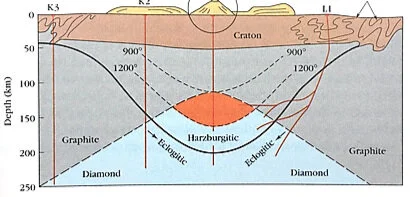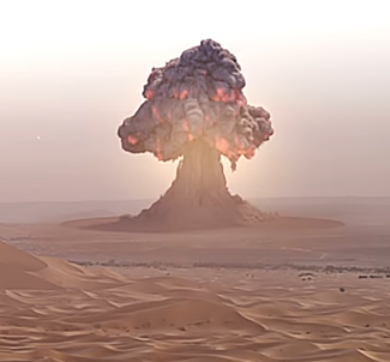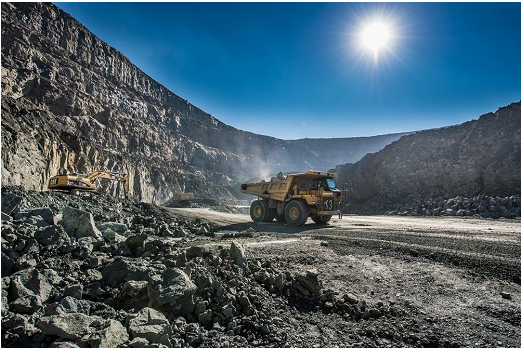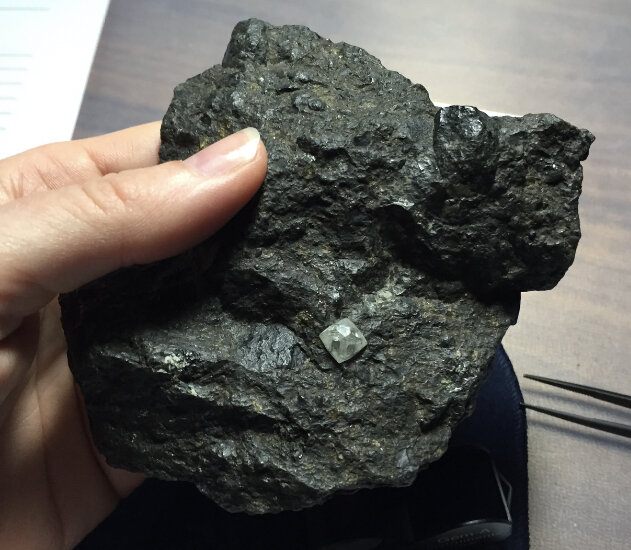Diamond Genesis

Almost everything to do with diamond is spectacular and very, very old.
And, until recently, the mystery was: how could tectonic forces bring them through the oldest, thickest and most inert crust on Earth?
We know that diamonds which are of a quality, size and quantity for commercial mining viability are all found in specific locations: in pipes that reach the surface of narrow volcanic eruptions through the most ancient crust on Earth, or at secondary locations fed by such pipes that have been eroded by millions of years of glacier, wind, rain, river and tidal action. On average globally, over 80% mined diamonds by volume are found in their primary source location ie where the volcanic intrusion occurred eg Jwangeng in Botswana, with just under 20% at a secondary location some distance away due to continual erosion and sedimentary deposition, eg. river sediments in Kono district Sierra Leone.
Star Dust
Tiny micro diamonds are all around us in the heavens. Diamonds, being pure carbon, were one of the very first materials in the Universe that crystallised from swirling clouds of star dust a billion years after the Big Bang, and micro-diamonds are in the glittering spectrums of exploded supernovae in space.
Larger diamond crystals are found here on Earth. Our planet was formed from clouds of dust which coalesced into a solid planet around 4.5 billion years ago. Radiating heat deep from the centre is an inner core of solid iron and nickel about the size of the Moon 2,400 km in diameter, surrounded by a semi-liquid iron and nickel outer core, about 4000 degrees C and 2,300 km thick. The early Earth cooled slowly, and gradually around 3.2 billion years ago, the surface became affected by tectonics, then as now, by convecting currents ascending from the radioactive iron-nickel core, and covered in a thin skin of cool proto rock, with volcanism, emerging water and early continents of plates of rock crunching together like scum on a bubbling broth, raising mountains and tilting rock masses below others as they converged.
The essential feature for growing diamond crystals were these shields of early rock. There are 35 plates of early rocky crust - cratons - which now form the cores of continents around the globe, dated from 4 billion to 2.5 billion years old. The largest exposed ancient surface is the Slave Craton in the heart of Canada. These ancient plates sail majestically upon the upper mantle, a molton to semi molton porridge of crystalline minerals and super-hot fluids gently rotating in vast convection patterns.
The Goldilocks zone for diamond: cross section of 250km lithosphere showing ‘keel’ under craton and band of eclogite (black line); orange zone marks temperature and pressure zone for Goldilocks zone for diamond crystallisation and stabilisation (from Harlow, G. (Ed) 1998)
Diamond Porridge
Like Goldilocks’ porridge, at just the right temperature and pressure, diamonds crystallise over hundreds of millions or billions of years from a watery carbonate melt, 150 km or more trapped under the keels of these rocky plates at around 1,000C – relatively cool compared to other zones at this depth - but at enormous pressure 5GPa (a pressure equivalent to your big toe being squeezed by two Statues of Liberty, a pressure 50,000 times more than normal atmospheric pressure).
Diamonds also crystallise in a super metamorphosed rock called eclogite, a witches’ brew formed in subduction zones by heavy ocean crust dragged down by gravity under the fringes of continents, conveying ocean water and carbon in the form of decayed and fossilised life, at depths of over 100km and intense temperature and pressure. Eclogitic diamonds which escaped from the forces of subduction and ended up near the safe harbour zones of cratons were preserved, like their nursery-grown cousins.
The Goldilocks zone for diamond: cross section of 250km lithosphere showing ‘keel’ under craton and band of eclogite (black line); orange zone marks temperature and pressure zone for Goldilocks zone for diamond crystallisation and stabilisation (from Harlow, G. (Ed) 1998)
Here, in the Goldilocks zone, are diamonds in untold magnitude, even now. Those that reached the Earth’s surface were somehow caught up in fiery episodic eruptions and blasted to the surface, in volcanoes that must have been completely different to those which operate on Earth now.
Drive-by shooting
Diamonds are primarily found in cratons in ‘districts’ - areas peppered by pipes like a drive-by shooting. Slave Craton in Canada is home to almost 800 pipes. So the mystery was what eruptions could have had the ballistic power needed to bring these crystals to the surface from such depth, and through such immense thicknesses of stable continental core?
If anyone was alive to see this, perhaps a kimberlite explosion looked a bit like this. Image: GCImage: Iridesium, YouTube
Deadly Chemistry
Originating from the deep bowels of the planet, like a hellish version of the Very Hungry Caterpillar, these extreme volcanoes ate through the cratons’ silicate rock, refuelling as they shot to the surface. The magmas required an initial carbonite-like partial melt in the mantle which began to migrate upward from depths of around 500-900km. Instead of being blocked by any craton above them, they ripped through the keels picking up speeds of 70-80km per hour due to the abundance of acidic ‘fuel’ they assimilated on the way up through the rock. Any diamonds in their path were whipped up as they punched through the keel of the craton.
When the magma erupted at the surface it was in a missile form with a leading cone of super pressurised liquid CO2, like a colossal ‘soda pop’ blast, which turned to vapour at speeds of 5,000km per hour, emptying in 10 seconds. The cataclysmic flash freeze-preserved the diamond crystals within the magma. The cavity walls imploded and shock waves rebounded, filling the cavity with the surrounding country rocks. No lava flowed outwards, as the eruption was entombed instantly. Subsequent eruptions might have encased the first.
GCImage: Iridesium, YouTube
These extreme volcanoes were fuelled by a suite of unique deep origin magmas. The most common is kimberlite, named after the famous diamond mining district Kimberly, identified in South Africa in 1860’s, which forms a characteristic carrot shape pipe or ‘diatreme’. Incidentally, the famous pink diamonds of Australia are found in the magma lamproite, which has a slightly different chemical composition and even more explosive pattern due to a higher water content. The famous pink colours of Argyle’s rare diamonds are caused by the distortion of light passing through the crystals, twisted and warped during their violent flight upwards.
Although many pipes are known, ones bearing diamond are very rare. 6,500 kimberlite pipes are known globally, of which less than 3% are diamondiferous, and less than 1% of are economically viable, for instance, there are 380 known kimberlite pipes in Botswana but less than 10 are mined. Mines mostly have concentrations of at least around 30 carats of diamond per hundred tonnes of ore (cpht) or 1 part of diamond to around 16,000,000 parts of rock, and in the case of the most productive mine, Argyle in Australia, as high as to 220 cpht.
Open pit mining in Lesotho. Image: Gem Diamonds
Super Continental Rifts
The events that caused such deep magmatism and catastrophic eruptions are linked to major tectonic events in the Earth’s history, first at around 1.2 billion years at the break-up of the first super-giant continent Rodinia, and then again from 400 million years ago during the break-up of the next super-giant continent Pangea, and again in the Jurassic period 200-145 million years ago when Pangea’s southern half, Gondwana, split apart to become the modern continents of South America, Africa, India, Australia & Antarctica. A final event occurred in the Cretaceous at 50-40 million years ago as North America moved over a complex subduction zone to the north west.
The reason why such deep magmatism occurred at all is due to the effect that such expansive supercontinents had on the mantle convection processes and deep mantle hot spots. The supercontinents in effect put a ‘lid’ on the mantle, insulating heat loss, smothering convection, and as deep plumes and hot spots welled up underneath over tens of millions of years, uplift and rifting began to split the seams of the conjoined continental borders; tectonics drove the lithosphere plates apart as new oceans opened up between them.
So, diamonds were born of violent tectonic events and simple but deadly chemistry: when super continents broke up over bubbling hot spots and deep magma plumes, the alkaline magma blasted through diamond nursery zones, siezing up crystals as it consumed the thick acidic crust it was blasting through.
Fortunately, we humans have never witnessed anything this violent during our time on Earth, as the last wave of kimberlite eruptions occurred over 40 million years ago, but eventually micro diamonds may be blasted from our splintered Earth when the Sun explodes into clouds of star dust in 4 – 5 billion years.
Perfect diamond octahedron trapped in chunk of loose kimberlite. Hand specimen collection of Gem-a. Image: the author





